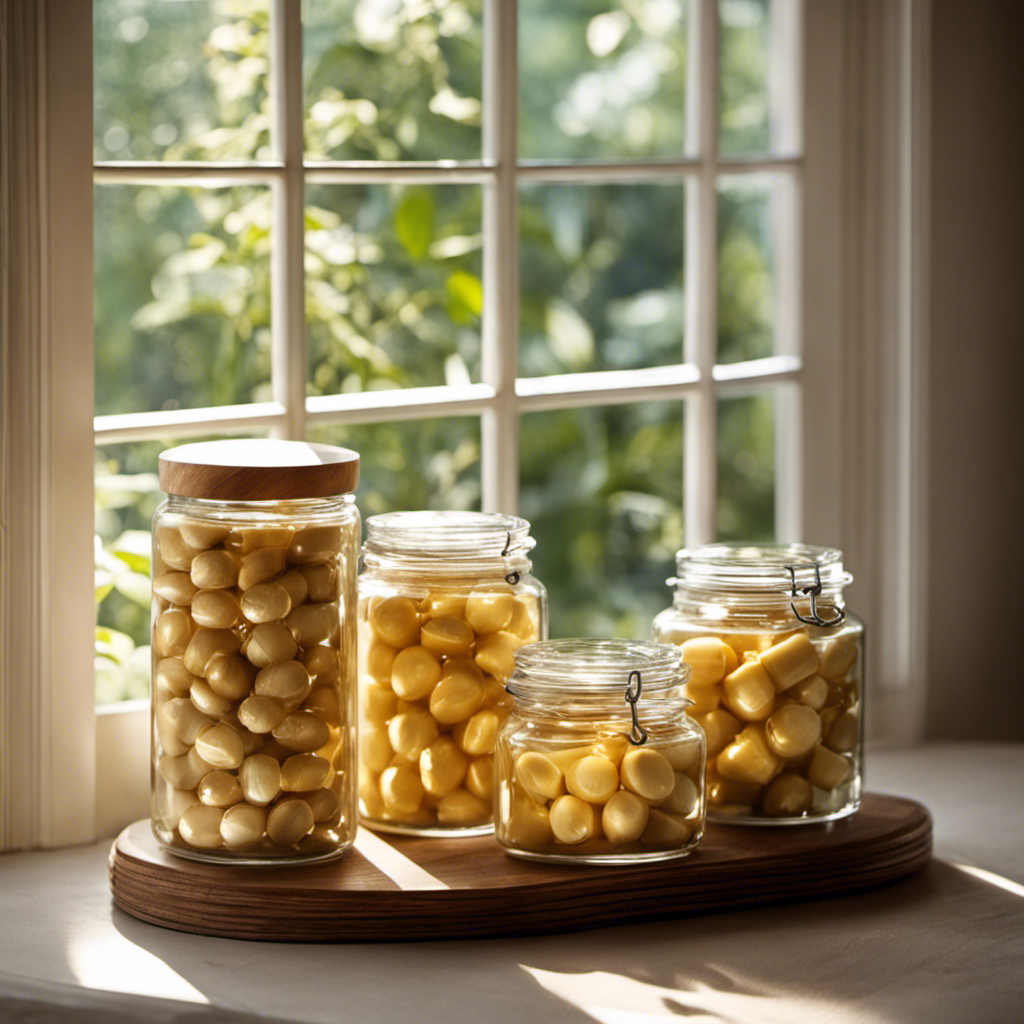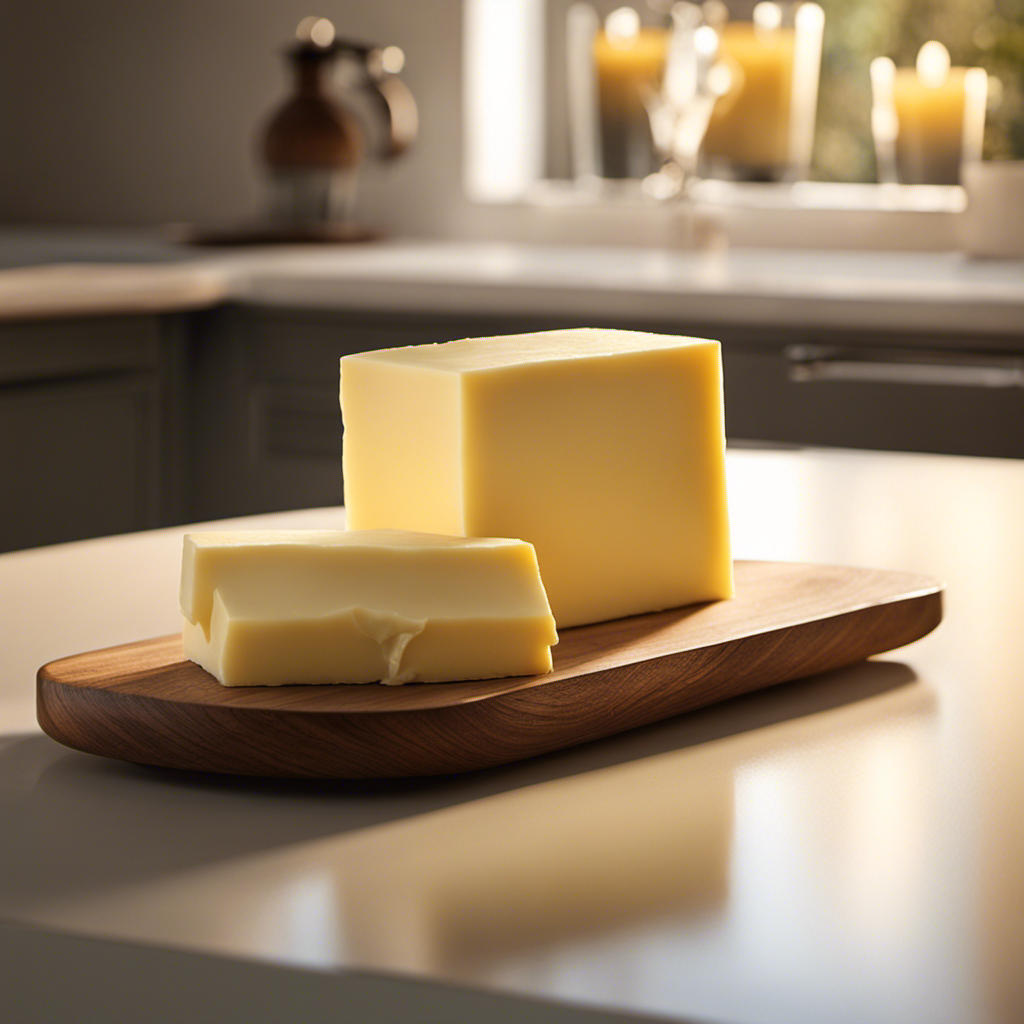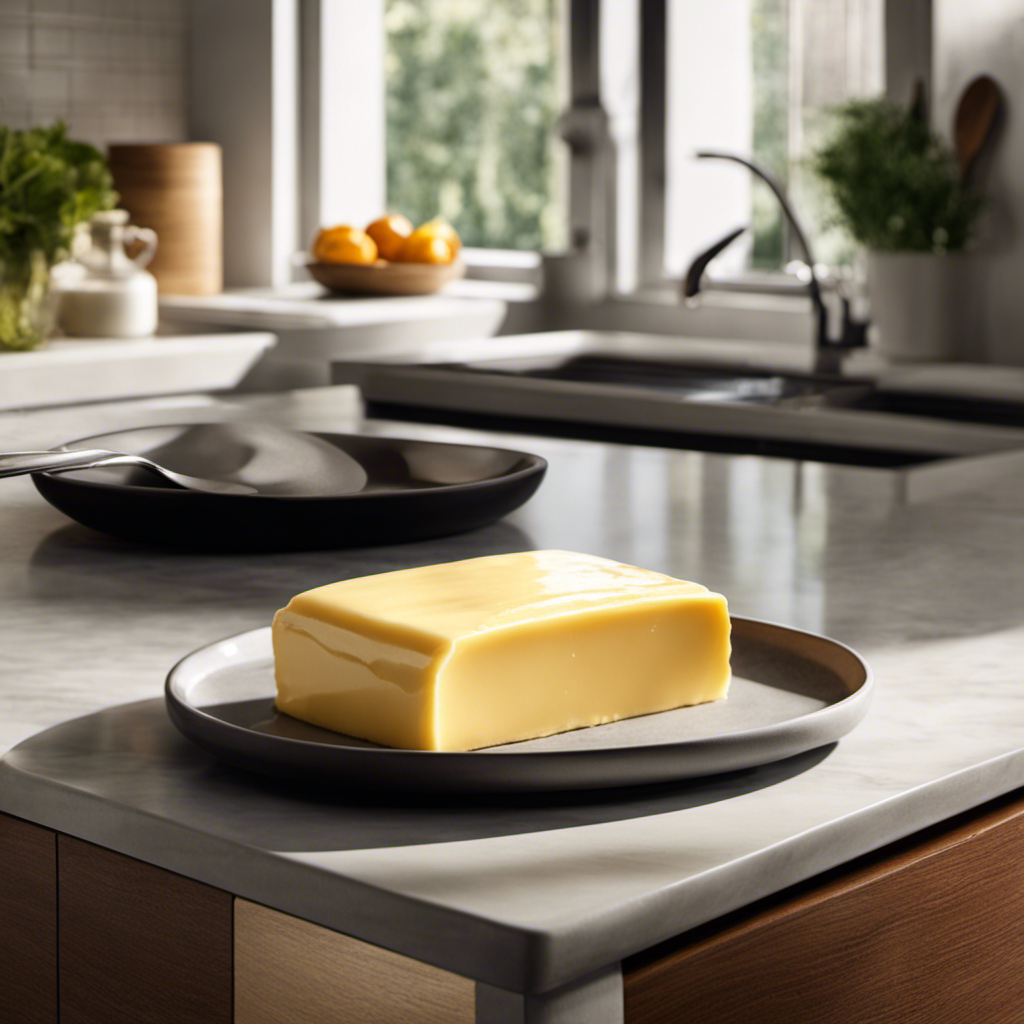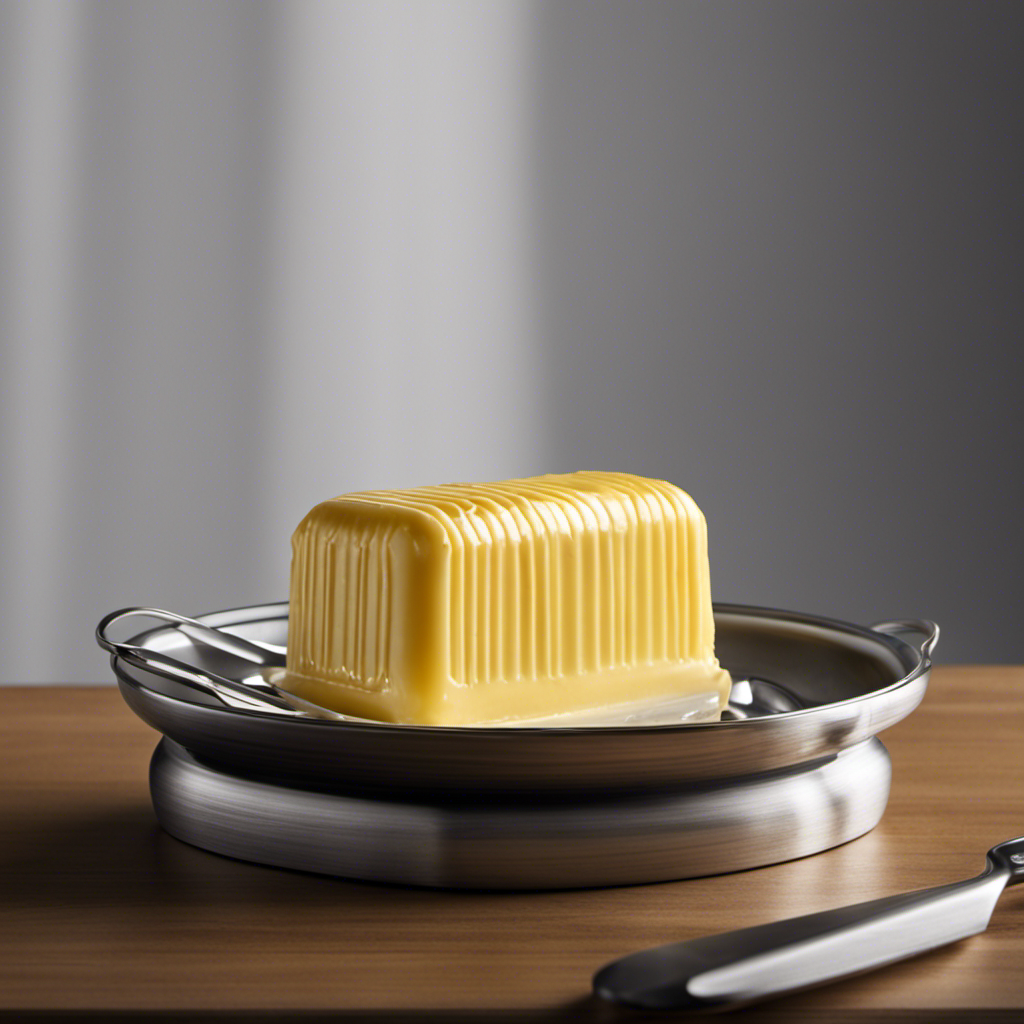As a lover of shea butter for its numerous benefits, I recognize the significance of correct storage to preserve its quality and effectiveness.
In this article, I will share my knowledge and expertise on how to store shea butter correctly. From choosing the right container to protecting it from light and air exposure, I will provide you with valuable tips to prolong its shelf life and ensure its maximum potency.
Let’s dive in and learn how to store shea butter like a pro!
Key Takeaways
- Store shea butter in a cool, dark place to protect it from temperature and light sensitivity.
- Choose the right container, such as glass jars or stainless steel containers, to preserve the quality of shea butter.
- Consider the size of the container based on storage needs and frequency of use.
- Properly label containers and track dates to ensure freshness, prevent mix-ups, and prioritize product rotation.
Understanding Shea Butter Storage Requirements
Before storing shea butter, it’s important to understand its storage requirements.
Choosing the right packaging is crucial to maintain its quality and shelf life. Shea butter is sensitive to temperature and light, so it’s best to store it in a cool, dark place. Airtight containers, such as glass jars or plastic containers with tight lids, are ideal for preserving its freshness.
It’s also essential to consider the climate in which you are storing the shea butter. In warmer climates, it’s advisable to refrigerate or store it in a cool room to prevent melting or softening. On the other hand, in colder climates, it may become solid and hard, but it can easily be warmed up by rubbing it between your palms.
Understanding these storage requirements will help ensure that your shea butter remains in top condition for an extended period.
Choosing the Right Container for Shea Butter
When it comes to choosing the right container for shea butter, two key factors to consider are the material and size of the container.
The material of the container plays a crucial role in preserving the quality and properties of the shea butter.
Additionally, selecting the appropriate size of the container ensures that you have enough storage space while also promoting ease of use.
In this discussion, I will explore the different materials available for shea butter containers and provide insights on selecting the optimal size for your needs.
Material for Shea Container
You’ll need a suitable material for storing your shea butter. There are several options available that can help maintain the quality of your shea butter and ensure its longevity. Here are some popular choices:
-
Glass jars: These are a great option as they are non-reactive and do not absorb any odors or flavors.
-
Stainless steel containers: These containers are durable and provide airtight storage, keeping your shea butter fresh.
-
Plastic containers: Look for containers made from high-quality, food-grade plastic that is BPA-free.
-
Silicone molds: These are a convenient option for shaping your shea butter into small, individual portions.
-
Ceramic jars: These can add a touch of elegance to your storage options, while also keeping your shea butter safe.
When choosing a shea container, it’s important to consider the material’s ability to maintain the quality of the shea butter.
Now, let’s move on to discussing the ideal size for your shea container.
Size of Shea Container
For optimal storage, choose a size that suits your needs and allows easy access to your shea container.
When it comes to choosing the appropriate size for storing shea butter, it is important to consider how much shea butter you intend to store and how often you will be using it.
If you use shea butter frequently and in large quantities, it may be more convenient to store it in bulk. This way, you can avoid the hassle of constantly refilling smaller containers.
However, if you only use shea butter occasionally or in smaller amounts, a smaller container would be more practical and space-saving.
Ultimately, the size of your shea container should be determined by your personal preferences and storage needs.
Temperature and Humidity Considerations for Storing Shea Butter
When it comes to storing shea butter, maintaining optimal storage conditions is crucial.
The temperature and humidity levels in which shea butter is stored can greatly impact its quality and shelf life.
To ensure the longevity of your shea butter, it’s important to store it in a cool, dry place, away from direct sunlight and moisture exposure.
Optimal Storage Conditions
To maintain the quality of shea butter, it’s important to store it in optimal conditions. Proper storage will help prevent rancidity and ensure that the butter remains fresh and usable for a longer period of time. Here are some key points to consider when storing shea butter:
-
Optimal storage temperature: Keep shea butter in a cool, dry place with a temperature between 60-75°F (15-24°C). Avoid extreme temperatures as they can affect the quality and texture of the butter.
-
Avoid direct sunlight: Exposure to sunlight can cause the butter to melt and lose its beneficial properties. Store it in a dark, opaque container or wrap it in aluminum foil to protect it from light.
-
Moisture control: Moisture can lead to mold growth and spoilage. Store shea butter in an airtight container to prevent moisture from seeping in.
-
Avoid strong odors: Shea butter has a subtle, nutty aroma that can absorb strong odors. Store it away from other strongly scented products to maintain its natural fragrance.
-
Use within recommended time frame: While shea butter has a long shelf life, it’s best to use it within 1-2 years to ensure maximum freshness and efficacy.
Avoid Moisture Exposure
Properly sealing the container will help prevent moisture from compromising the quality of your shea butter. Moisture is one of the main culprits when it comes to the deterioration of shea butter. When exposed to moisture, shea butter can become rancid, lose its beneficial properties, and even develop mold or bacteria.
To avoid contamination and preserve the quality of your shea butter, it is crucial to store it in a dry and cool place, away from direct sunlight or heat sources. Additionally, make sure to tightly seal the container after each use to minimize moisture exposure. Consider using airtight containers or wrapping the shea butter in a moisture-resistant material such as plastic wrap before sealing it.
The Importance of Proper Labeling and Date Tracking
You should always make sure to label your shea butter containers properly and track the dates to ensure freshness. Proper labeling and date tracking are essential for maintaining the quality and effectiveness of your shea butter. Here are some reasons why it is important:
-
Organizational purposes: Clear labels help you easily identify the type and purpose of each shea butter container.
-
Prevent mix-ups: Proper labeling ensures you don’t accidentally use expired or different shea butter products.
-
Freshness maintenance: Tracking the dates allows you to use the shea butter while it is still at its best quality.
-
Product rotation: By knowing the dates, you can prioritize using older shea butter first to prevent waste.
-
Safety measure: Accurate labeling helps you avoid using shea butter that may cause allergies or other adverse reactions.
Protecting Shea Butter From Light and Air Exposure
After properly labeling and tracking the dates of my shea butter, the next step is to protect it from light and air exposure. Both light and air can degrade the quality of shea butter and reduce its effectiveness. To prevent this, I store my shea butter in a cool, dark place, away from direct sunlight. Additionally, I ensure that the container is tightly sealed to prevent air from entering.
To help you better understand how to protect shea butter from light and air exposure, here are some shea butter storage hacks:
| Storage Hack | Description |
|---|---|
| Use Dark-Colored Containers | Dark-colored containers help block out light and protect the shea butter from degradation. |
| Vacuum Seal Bags | Vacuum-sealing shea butter helps remove excess air, preventing oxidation. |
| Store in the Fridge | If you live in a particularly hot climate, storing shea butter in the fridge can help protect it from heat and maintain its quality. |
| Use Small Containers | Transferring shea butter into smaller containers reduces the exposure to air when you open it, preserving its freshness. |
Tips for Prolonging the Shelf Life of Shea Butter
To extend the shelf life of shea butter, it’s important to keep it in a cool and dark place. This will help preserve its natural properties and prevent it from going rancid. Here are some tips for prolonging the shelf life of shea butter:
- Store it in an airtight container: This will protect it from exposure to air, which can cause oxidation and spoilage.
- Keep it away from heat: Heat can melt the shea butter and degrade its quality, so it’s best to store it in a cool environment.
- Avoid direct sunlight: UV rays can break down the beneficial compounds in shea butter, so keep it away from windows or other areas with direct sunlight.
- Don’t contaminate it: Make sure to use clean hands or tools when scooping out shea butter to prevent bacteria or other contaminants from affecting its quality.
- Check for signs of spoilage: If the shea butter develops an off smell or changes in texture or color, it’s likely gone bad and should be discarded.
In addition to its ability to moisturize and nourish the skin, shea butter has many other uses beyond skincare. It can be used as a natural hair conditioner, lip balm, and even as a base for homemade body butters and lotions. Its high concentration of vitamins and fatty acids make it a versatile ingredient in DIY beauty products.
Shea butter can also be used to soothe minor burns, reduce inflammation, and promote wound healing. Its anti-inflammatory properties make it a popular choice for relieving dry, itchy skin conditions like eczema and psoriasis. With its numerous benefits, shea butter is truly a versatile and valuable ingredient in any skincare routine.
Frequently Asked Questions
Can I Store Shea Butter in a Plastic Container?
Yes, you can store shea butter in a plastic container. However, it is recommended to use an airtight container to keep it fresh and prevent oxidation. This will help maintain its quality and extend its shelf life.
How Long Does Shea Butter Last if Stored Properly?
Shea butter can last up to 2 years if stored properly. I once found a jar of shea butter in the back of my closet that was 3 years old and it was still good!
Is It Necessary to Keep Shea Butter Refrigerated?
It is not necessary to refrigerate shea butter. However, proper storage is important for maintaining its shelf life. Store it in a cool, dry place away from direct sunlight to preserve its quality and effectiveness.
Can I Use a Regular Glass Jar to Store Shea Butter?
Yes, you can use a regular glass jar to store shea butter. However, it’s important to consider other storage options. The best containers are ones that are airtight and made of dark-colored materials to protect the shea butter from light and air exposure.
How Often Should I Check the Expiration Date of Shea Butter?
I check the expiration date of my shea butter every six months to ensure its freshness. It’s important to stay aware of the shelf life to make the most of its benefits.
Conclusion
In conclusion, properly storing shea butter is essential to maintain its quality and prolong its shelf life. By understanding the storage requirements, choosing the right container, and considering temperature and humidity conditions, you can ensure the longevity of your shea butter.
Additionally, proper labeling and date tracking will help you keep track of its freshness. Don’t forget to protect your shea butter from light and air exposure, as these can degrade its quality.
So, why compromise the effectiveness of your shea butter when you can easily follow these storage tips?










